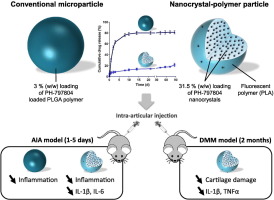Journal of Controlled Release ( IF 10.5 ) Pub Date : 2018-03-07 , DOI: 10.1016/j.jconrel.2018.03.007 Pierre Maudens , Christian Alexander Seemayer , François Pfefferlé , Olivier Jordan , Eric Allémann

|
This study aimed to formulate nanocrystal-polymer particles (NPPs) containing the potent p38α/β MAPK inhibitor PH-797804 (PH-NPPs) and to test their extended-release properties over months in comparison to those of conventional PH microparticles for the intra-articular treatment of inflammatory and mechanistic murine models mirroring aspects of human osteoarthritis (OA). The steps of the study were (i) to formulate PH nanocrystals (wet milling), (ii) to encapsulate a high payload of PH nanocrystals in fluorescent particles (spray drying), (iii) to assess in vitro drug release, (iv) to evaluate PH-NPP toxicity to human OA synoviocytes (MTT test), (v) to investigate the in vivo bioactivity of the particles in mice in an inflammatory antigen-induced arthritis (AIA) model (using histology and RT-qPCR) and (vi) to investigate the in vivo bioactivity of the particles in the OA model obtained by mechanistic surgical destabilization of the medial meniscus (DMM) (using histology, micro-CT, and multiplex ELISA). The PH nanocrystals stabilized with vitamin E TPGS had a monomodal size distribution. The PH-NPPs had a mean diameter of 14.2 μm and drug loading of ~31.5% (w/w), and ~20% of the PH was released over 3 months. The NPPs did not exhibit toxicity to cultured human OA synoviocytes at 100 × IC50. Finally, in vivo studies showed good retention of PH-NPPs in the joint and adjacent tissues for up to 2 months, and the PH-NPPs exhibited good functional relevance by significantly reducing inflammation and joint destruction and by inhibiting several biomarkers (e.g., IL-1β). In conclusion, local treatment with PH-NPPs, used as an extended-release drug delivery system, improved inflammation and joint degradation in two distinct mouse models, indicating treatment potential for human OA.
中文翻译:

嵌入微粒中的有效p38 MAPK抑制剂的纳米晶体:在骨关节炎的炎症和机制鼠模型中的治疗作用
这项研究旨在配制含有强效p38α/βMAPK抑制剂PH-797804(PH-NPPs)的纳米晶体聚合物颗粒(NPPs),并测试其与常规PH微粒相比在几个月内的缓释性能。炎性和机械性小鼠模型的关节治疗反映了人类骨关节炎(OA)的各个方面。研究的步骤是(i)配制PH纳米晶体(湿磨),(ii)将高有效载荷的PH纳米晶体封装在荧光颗粒中(喷雾干燥),(iii)评估体外药物释放,(iv)评估PH-NPP对人OA滑膜细胞的毒性(MTT试验),(v)研究体内炎症性抗原诱导的关节炎(AIA)模型中小鼠体内颗粒的生物活性(使用组织学和RT-qPCR)和(vi)研究内侧模型的机械性去稳定作用获得的OA模型中颗粒的体内生物活性半月板(DMM)(使用组织学,微型CT和多重ELISA)。用维生素E TPGS稳定的PH纳米晶体具有单峰尺寸分布。PH-NPP的平均直径为14.2μm,载药量约为31.5%(w / w),并且在3个月内释放了约20%的PH。NPP在100×IC 50下对培养的人OA滑膜细胞没有毒性。最后,体内研究表明,PH-NPPs在关节和邻近组织中的保留时间长达2个月,并且通过显着减少炎症和关节破坏并抑制多种生物标志物(例如IL-1β),PH-NPPs具有良好的功能相关性。总之,PH-NPPs的局部治疗(用作缓释药物递送系统)在两种不同的小鼠模型中改善了炎症和关节降解,表明对人OA的治疗潜力。










































 京公网安备 11010802027423号
京公网安备 11010802027423号